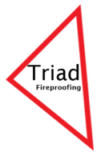What is Sprayed Fireproofing?
Sprayed fireproofing, also known as spray-applied fire-resistive materials (SFRMs), involves coating structural elements with fire-resistant materials. This coating can significantly delay the spread of fire, giving occupants more time to evacuate and reducing structural damage.
Benefits of sprayed fireproofing
Compliance: Meets building codes and regulations for fire safety.
Enhanced Safety: By slowing down the structural failure during a fire, sprayed fireproofing can save lives.
Property Protection: Reducing fire spread can minimize damage, saving costly repairs.
Versatility: Suitable for various structures, including steel, wood, and concrete.
Cost-Effective: An affordable method to add fire resistance to a building.
Types of sprayed fireproofing
Cementitious Fireproofing: Made from a mixture of gypsum or Portland cement, this type is highly effective and widely used.
Intumescent Coatings: Expand when exposed to heat, providing an insulating barrier. Click here to learn more
Fibrous Fireproofing: Uses mineral fibers and binders, ideal for complex shapes and areas with high vibration.
Common Uses of Sprayed Fireproofing
Commercial Buildings: Protects steel frameworks in skyscrapers and office buildings.
Industrial Facilities: Shields structures in factories and warehouses from fire hazards.
Residential Properties: Enhances safety in multi-story residential buildings.
Public Structures: Ensures safety in schools, hospitals, and government buildings.
